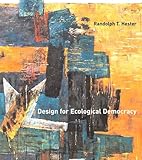Design for ecological democracy Randolph T. Hester.
Material type: TextPublication details: 2006. MIT Press Cambridge, MADescription: x, 509 p. : ill, ; 23 cmISBN:
TextPublication details: 2006. MIT Press Cambridge, MADescription: x, 509 p. : ill, ; 23 cmISBN: - 9780262515009 (pbk.)
- 23 307.12160973 HES 001530
| Item type | Current library | Call number | Status | Date due | Barcode |
|---|---|---|---|---|---|
 Book
Book
|
Indian Institute for Human Settlements, Bangalore | 307.12160973 HES 001530 (Browse shelf(Opens below)) | Available | 001530 |
Includes bibliographical references (p. 459-485) and index.
Introduction
Enabling form: "We got to know our neighbors"
Centredness
Connectedness
Fairness
Sensible status seeking
Sacredness
Resilient form: Life, liberty, and the pursuit of sustainable happiness
Particularness
Selective diversity
Density and smallness
Limited extent
Adaptability
Impelling form: "Make a city to touch the people's hearts"
Everday future
Naturalness
Inhabiting science
Reciprocal stewardship
Pacing
Epilogue.
Over the last fifty years, the process of community building has been lost in the process of city building. City and suburban design divides us from others in our communities, destroys natural habitats, and fails to provide a joyful context for our lives. In Design for Ecological Democracy, Randolph Hester proposes a remedy for our urban anomie. He outlines new principles for urban design that will allow us to forge connections with our fellow citizens and our natural environment. He demonstrates these principles with abundantly illustrated examples--drawn from forty years of design and planning practice--showing how we can design cities that are ecologically resilient, that enhance community, and that give us pleasure.Hester argues that it is only by combining the powerful forces of ecology and democracy that the needed revolution in design will take place. Democracy bestows freedom; ecology creates responsible freedom by explaining our interconnectedness with all creatures. Hester's new design principles are founded on three fundamental issues that integrate democracy and ecology: enabling form, resilient form, and impelling form. Urban design must enable us to be communities rather than zoning-segregated enclaves and to function as informed democracies. A simple bench at a centrally located post office, for example, provides an opportunity for connection and shared experience. Cities must be ecologically resilient rather than ecologically imperiled, adaptable to the surrounding ecology rather than dependent on technological fixes. Resilient form turns increased urban density, for example, into an advantage. And cities should impel us by joy rather than compel us by fear; good cities enrich us rather than limit us. This book is essential reading for designers, planners, environmentalists, community activists, and anyone else who wants to improve a local community.


There are no comments on this title.